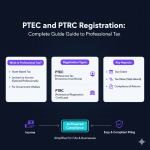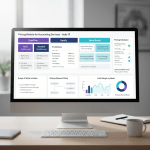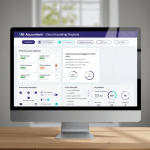Key takeaways
- Indian businesses leak money to hidden fees, bank charges analytics helps detect, analyze, and recover those costs with precision.
- Standardize messy Indian bank narrations, split base fees and GST correctly, and automate ledger posting for clean books.
- Use four pillars, hidden fee detection, charge pattern analysis, bank cost optimization, and fee dispute management, to create ongoing savings.
- CA firms can productize quarterly bank fee audits, deliver measurable ROI, and open new advisory revenue streams.
- Tools like AI Accountant provide OCR, narration normalization, GST mapping, and Tally or Zoho sync designed for Indian data.
Table of contents
What Is Bank Charges Analytics India and Why It Matters Now
Bank charges analytics India is the systematic process of detecting, analyzing, and optimizing banking costs for Indian businesses using specialized software and AI tools. It moves beyond merely spotting fees, it uncovers patterns, flags anomalies, and converts granular data into rupee savings.
Banks use inconsistent codes, one might tag a fee as CHRG-001, another as MISC-TXN-FEE, manual checks miss these variations. The result is silent cash leakage through AQB penalties, NEFT or RTGS or IMPS charges, POS MDR, and forex markups. For a business processing ₹10 crore annually, a 0.15 percent fee reduction means ₹1.5 lakh saved each year, and that is before you recover duplicate or incorrect charges.
Bank charges analytics protects working capital, sharpens fee negotiations, and tightens GST compliance across ledgers.
Understanding Bank Charges in India: The Complete Taxonomy
Common Bank Charges Every Indian Business Faces
Transaction charges include NEFT, RTGS, IMPS, and sometimes UPI for corporates with slabs by amount and timing. Account maintenance charges like AQB non maintenance penalties strike regularly. Cash handling fees rise quickly for cash heavy operations. Payment infrastructure charges cover POS MDR and terminal rentals that hit margins daily. International transaction fees combine forex markups and GST. Service charges span SMS alerts, cheque books, DD or PO, duplicate statements, and dispute charges. Trade finance charges apply to LCs or BGs, often as percent based or flat fees.
GST Implications on Bank Charges
Not all bank charges attract GST, misclassification creates compliance risk. Accurate ledger mapping in Tally or Zoho Books is essential, the wrong tax treatment can trigger notices. Build precise rules for fees that are taxable versus exempt, split base and GST for perfect posting.
Building Your Data Foundation for Bank Charges Analytics
Data Sources You Need to Track
- Bank statements in PDF, CSV, or Excel, standardization is critical across banks.
- CMS reports that detail bulk collections and payouts with separate charge structures.
- POS or gateway settlements covering MDR deductions and settlement timings.
- Bank fee schedules and advisories to compare contracted rates against actual charges.
Key Challenges in Indian Banking Data
Indian bank narrations are inconsistent, see Inconsistent narration codes for why the same fee looks different across accounts. Reversal codes are confusing, a reversed transaction may still carry charges. GST is often bundled, so you must separate base fee and tax components.
Manual processing is slow and error prone. Tools like OCR and NLP in AI platforms clean Indian formats, normalize charge descriptions, and attach GST codes for automated posting. Source
The Four Pillars of Bank Charges Analytics India
Pillar 1: Hidden Fee Detection
Hidden fees silently erode margins. Duplicate charges occur on POS MDR or NACH return penalties. Tariff jumps creep in without notice. GST errors can add up over thousands of transactions. Failed transaction charges hurt most when no value was delivered.
Use rules and outlier analysis, set alerts for month over month spikes, charges exceeding thresholds, and branch or instrument anomalies. Source
Pillar 2: Charge Pattern Analysis
Break fees by instrument to see whether NEFT is costlier than IMPS for similar bands. Analyze by merchant or terminal to find high MDR channels. Branch level drill downs can expose overcharging locations. Track KPIs like fees as percent of value, average MDR, forex markup bps, and cheque return rates. Compare pre and post negotiation trendlines and auto map categories to the right ledgers and GST codes. Source
Pillar 3: Bank Cost Optimization
Benchmark charges against public fee schedules and peer medians. Route payments intelligently, for small urgent amounts IMPS can beat NEFT, batch where possible to reduce per transaction costs. Negotiate with data, volume based evidence improves outcomes. Optimize account structures, pool balances across entities to meet higher thresholds and win waivers. Re benchmark quarterly as policies change. Source
Pillar 4: Fee Dispute Management
Automate detection and evidence packs, include transaction IDs, applicable fee schedules, and GST splits. File disputes with your RM, maintain a status register, escalate through internal grievance channels, and use the RBI Ombudsman as the final step. Reconcile credits carefully, handle GST implications on reversals, and measure dispute success rates. Source
Implementing Bank Charges Analytics: A Step-by-Step Approach
Getting Started with Automated Analytics
- Connect and ingest data, upload PDFs, CSVs, or Excels, let automation classify charges correctly.
- Sync with accounting systems, connect Tally or Zoho Books, tag GST codes automatically, post to correct ledgers.
- Set up dashboards, watch trendlines, instrument wise breakdowns, forex analysis, and flags, in real time.
- Configure alerts, set thresholds, and schedule automated charge review reports.
- Enable dispute tracking, tag exceptions, attach evidence, and track to closure.
- Plan for the future, consider Account Aggregator APIs and predictive analytics for cash flow forecasting.
Building Your Monthly Review Process
Track fees as percent of total collections and payments, monitor cost per instrument, compute effective MDR and forex markup bps, count outliers and their rupee impact, track dispute win rates and recovered amounts, and compare charge trends after negotiations against targets. Generate exception reports for stakeholders, highlight wins, and focus areas.
Tools and Software for Bank Charges Analytics India
Essential Features to Look For
- Indian bank coverage across SBI, HDFC, ICICI, Axis, and more.
- Accurate fee and GST splitting for compliance and clean reconciliation.
- Customizable hidden fee detection tuned to your context.
- Integrations with Tally and Zoho Books for bi directional sync.
- Security at ISO 27001, SOC2, and Indian data residency standards.
Recommended Bank Charges Analytics Tools
- AI Accountant, purpose built for Indian formats with OCR or NLP, automatic GST mapping, and Tally or Zoho integration, at scale.
- QuickBooks, basic bank feeds and categorization, limited for Indian formats.
- Xero, strong reconciliation, moderate charge analytics for global formats.
- Zoho Expense, expense tracking with some bank fee analysis in the Zoho suite.
- FreshBooks, simple expense tracking with limited Indian bank coverage.
ROI and Business Case for Bank Charges Analytics
Calculating Your Savings Potential
On ₹10 crore annual payments, a 0.15 percent reduction saves ₹1.5 lakh. Hidden fee recovery often adds 0.5 to 1 percent of value, that is ₹5 to 10 lakh. Time saved is substantial too, manual reviews might take 20 to 30 hours per month, automation cuts this to two or three hours of exceptions.
Creating New Revenue Streams for CA Firms
Offer quarterly banking cost advisory at ₹10,000 to ₹25,000 per client per quarter, scale across 50 clients for ₹20 to ₹50 lakh of recurring revenue. The platform handles parsing and detection, you deliver negotiation strategy and governance.
Common Pitfalls and Risk Management
Data Quality Challenges
Inconsistent narrations change without notice, maintain a codebook and refresh mappings. AI false positives require human review, not every anomaly is an error. Policy changes happen frequently, re benchmark every quarter.
Compliance and Privacy Considerations
Follow Indian data protection norms strictly. Maintain audit trails for every dispute. Handle GST on reversals carefully so input tax credit remains correct, coordinate with tax teams on refunds.
Advanced Strategies for Large Organizations
Multi-Entity Consolidation
Centralize analytics across entities to expose group level leakage, identify which subsidiaries pay the most, and leverage combined volumes for better terms. Build internal benchmarks so Entity A learns from Entity B’s lower NEFT costs.
Predictive Analytics for Fee Forecasting
Use historical patterns to forecast fees by season, product, and channel. Budget with trendlines, simulate routing changes, and pick the least cost path before execution.
Getting Started Today: Your Action Plan
Quick Wins for Immediate Impact
Run a 30 day charges audit, upload statements to an analytics tool, and list your top ten fee categories by value. Chase obvious errors, duplicates and wrong GST rates, and file disputes immediately. Benchmark against published tariff cards to spot premium rates.
Building Long-term Capabilities
Connect accounting systems for continuous monitoring. Reserve two hours monthly for dashboard led reviews. Train staff on flagging and escalation, and standardize with dispute letter templates and KPI trackers.
Partnering for Success
Engage specialized advisors initially, and evaluate platforms that feel like a quiet assistant, not another system to manage. Join peer groups focused on banking optimization, share playbooks, and learn faster.
The Future of Bank Charges Analytics in India
Emerging Technologies and Trends
Account Aggregator rails will enable direct feeds and real time monitoring. GSTN integration will automate tax checks, reconcile fees with returns, and optimize input tax credit. AI models will predict fee impact before transactions occur, enabling proactive optimization.
Preparing for Tomorrow
Build data discipline now, train finance teams on analytics, and track regulatory changes from RBI and industry bodies for emerging fee rules and caps.
Conclusion: Making Bank Charges Analytics India Work for You
Bank charges analytics India turns an unavoidable cost into a managed, optimized expense. Combine hidden fee detection, pattern analysis, cost optimization, and disciplined disputes to protect cash, and strengthen compliance. Start with one audit, file that first dispute, and stand up dashboards, every day delayed is money lost.
Let technology act as your quiet assistant while you focus on growth. Businesses that master bank charges analytics today will enjoy lower costs, better cash flow, and stronger compliance tomorrow.
FAQ
How should a CA structure ledgers in Tally for bank charges with correct GST split
Create separate ledgers for bank charges taxable, bank charges exempt, and GST on bank charges, split the base fee and GST at source, then map narration rules so IMPS or NEFT or RTGS, POS MDR, cash handling, and forex charges post to the correct ledgers. AI tools like AI Accountant auto split base and GST from statements and push entries to Tally, reducing manual errors.
What evidence does a bank need to reverse incorrect fees during a dispute
Share transaction IDs, date or time, narration text, applicable tariff from the bank’s schedule, and GST calculation proof. Export an evidence pack from an analytics tool like AI Accountant, attach it to your email to the RM, and maintain a dispute register with status, expected credit, and due dates.
How do I quantify effective MDR across gateways or terminals for client advisory
Compute total MDR and related charges divided by gross settlement value, adjust for refunds or chargebacks, and compare across terminals and gateways. Dashboards in AI Accountant can show MDR trends by merchant ID, terminal, and brand, giving negotiation leverage.
What is the best approach to detect duplicate bank charges without manual scanning
Use rules plus anomaly detection, match on amount, instrument, merchant or branch, and time window, then look for repeats. AI Accountant flags likely duplicates and failed transaction charges, you review exceptions and trigger disputes with one click.
How can CA firms price a recurring bank fee audit service and show ROI
Offer quarterly reviews at ₹10,000 to ₹25,000 per client, track recovered charges, fee reductions, and time saved, and show a simple payback report. Tools like AI Accountant generate recovery and optimization reports you can brand for clients.
How do I map Indian bank narration codes reliably when banks keep changing formats
Maintain a living codebook, use machine learned parsers that adapt to new narrations, and run periodic validation. Platforms such as AI Accountant normalize narrations across SBI, HDFC, ICICI, Axis, and more, reducing breakage when codes shift.
How should I treat GST on reversed bank charges for input tax credit
When a fee is reversed, pass a corresponding GST adjustment to avoid overstated ITC, tie the reversal to the original charge with a reference number, and keep documentation for audits. Automated reversal handling in AI Accountant ensures clean GST trails.
Which KPIs should I include in a monthly bank charges dashboard for CFO review
Track fees as percent of collections and payouts, cost per instrument, effective MDR, forex markup bps, cheque return rates, hidden fee alerts, dispute win rate, and recovered amounts. AI Accountant can assemble these into one view for faster decisions.
Can Account Aggregator feeds eliminate manual uploads for bank fee analytics
Yes, with Account Aggregator enabled accounts, you can stream transactions into your analytics platform, enabling near real time detection and faster disputes. Solutions like AI Accountant are building AA based ingestion for continuous monitoring.
How do I benchmark a client’s fee structure before negotiating with the bank
Compare current charges with published tariff cards and peer medians, compute volume weighted cost per instrument, and simulate alternative routing. Present a data backed case using reports from AI Accountant to request waivers or revised slabs.
What controls can I set up to prevent fee leakages across multiple entities
Centralize statement ingestion, standardize category mappings, enforce alert thresholds, and run group level variance reports. Multi entity views in AI Accountant spotlight outliers and support group negotiations.
As a CA, how do I integrate bank fee analytics with Zoho Books or Tally without double work
Use a platform that supports bi directional sync, auto posts categorized charges with GST splits, and brings back reconciliation status. AI Accountant pushes clean entries into Tally or Zoho Books and pulls ledger confirmations, so you only handle exceptions, not every line item.




